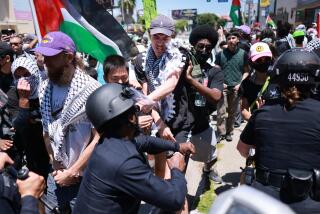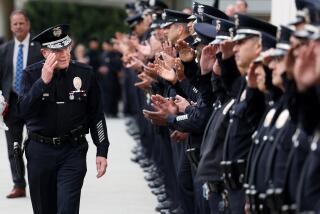LAPD and Protesters Study the Lessons of Philadelphia
- Share via
PHILADELPHIA — As Los Angeles gears up for mass protests during the upcoming Democratic National Convention, police and activists are looking to this city for clues on how to manage the potentially volatile drama created by mixing street theater, civil disobedience, scores of visiting dignitaries and a 15,000-member press corps.
The Los Angeles Police Department is taking a mixed message home from the Republican National Convention:
LAPD observers on the scene said they admire their Philadelphia colleagues’ restraint, including their refusal to use tear gas or pepper spray, even when days of orderly protests devolved into a running street battle in which demonstrators and police were injured.
“The message we will be conveying [to officers] is to be tolerant and do not take independent action,” said LAPD Cmdr. Mark Leap, who was in Philadelphia this week, watching the local police.
But Cmdr. Tom Lorenzen, who is heading the LAPD’s convention planning unit, is skeptical about the relevance of Philadelphia’s experience. The Democratic Convention in Los Angeles will be “180 degrees different for a million reasons,” he said. “The venue is different, the geography, the laws, the political agenda of the party in question, the reduced resources of the anarchists on the East Coast versus the West Coast. . . . This is going to be a hugely different event.”
LAPD observers were particularly impressed, however, with Philadelphia police tactics that outraged protesters and civil libertarians--including a preemptive strike on a warehouse containing puppets and signs that activists planned to use in the streets and the arrests of high-profile organizers as they walked the streets.
Activists say that they too have learned important lessons after their rowdy street action was portrayed in local media as unfocused and purposeless. “We’re going to have to be thinking about our media strategy and getting our message out,” said Jia Ching Chen, who has helped organize Los Angeles protests and was in Philadelphia this week.
In Los Angeles, he said, activists plan to make their points about police brutality, income inequality and other issues by blocking access to specific fund-raisers or corporate and government offices rather than random streets, as was done in Philadelphia.
“In L.A., it’s not about shutting down an area of town,” Chen said.
If there is one lesson to be taken from Philadelphia, it is that police and nonviolent protest organizers have difficulty controlling small bands of activists who attack police.
Some Tried to Provoke Police
Although the vast majority of demonstrators were peaceful, officials estimated that during Tuesday afternoon’s incident as many as 300 protesters either attacked police or tried to goad them into violence. Fifteen officers were injured, one with a concussion and another with a broken arm.
“I’ve never really experienced the intent to harm officers and the ferociousness of the intent that I saw the other night,” said Philadelphia Police Commissioner John Timoney, who was bruised while trying to stop demonstrators from trashing a parked car. “This is like the third or fourth city now, and L.A. might be the fifth where we’ve seen this.”
Los Angeles’ protest organizers have laid down more stringent action guidelines than their Philadelphia counterparts, urging all involved to refrain from violence or vandalism.
Still, Chen said, “it’s really something that we can’t control and can’t be accountable for because we understand that the [violent protesters’] actions are politically motivated.”
Further complicating matters, police and protesters will be operating in a dramatically different physical situation in Los Angeles, said the LAPD’s Lorenzen.
The Republicans gathered in a sports arena miles from Philadelphia’s heart, surrounded by iron fences and acres of parking lots. Protesters massed at the convention site only once--at the conclusion of one long, hot and orderly four-mile march from City Hall.
In contrast, the Democratic convention, will be at Staples Center in the heart of downtown. And after a federal judge ruled that the city was violating the 1st Amendment by trying to keep protesters away from the site, activists will be allowed to stand across the street from the arena’s entrance. Police also will be stretched far thinner than in Philadelphia because of Los Angeles’ sprawl and because the LAPD has fewer officers per city resident than the Philadelphia department has.
While Philadelphia attracted 2,000 to 4,000 activists, more are expected in Los Angeles. City officials have expressed particular concern about as many as 1,000 anarchists who are expected to attend a conference scheduled for the week of the Democratic convention. Many anarchists are pacifists, but some anarchist organizations espouse political vandalism.
Finally, the Philadelphia police were under pressure to control their response because of last month’s televised beating of a suspect after a wild car chase. LAPD officials say that they also feel pressure because of a televised event earlier this summer--the melee at Staples Center after the Lakers’ National Basketball Assn. championship in which a crowd smashed windows and police cars while officers stood back. That image, they say, strengthens the urge to be forceful, rather than restrained.
Yet Los Angeles police express admiration for the Philadelphia department’s calm. Timoney, Philadelphia’s personable commissioner, was a constant sight, bicycling through orderly marches on the first three days of last week and plunging into the street battles Tuesday. From the beginning, he said his department would “bend over backward” to accommodate protesters.
Last Monday, as thousands of local anti-poverty activists and out-of-town demonstrators prepared for a march without a permit from City Hall, Timoney and police officials negotiated with protesters’ attorneys on the street and ended up escorting the march down the city’s main artery with no arrests. Los Angeles officials say that they want the city attorney’s office to work with demonstrators’ lawyers in a similar manner.
“The police in many cases, but not all, did show patience, did show restraint,” said Larry Frankel, executive director of the American Civil Liberties Union of Pennsylvania.
Activists in Philadelphia seemed frustrated with their week’s work, especially because it got scant media coverage.
“It’s difficult,” said Chen. “You do have the media saying to us on our press calls that a march isn’t interesting enough. . . . The media isn’t interested in doing anything that isn’t hard-core” civil disobedience.
Police Raid on Warehouse
When that hard-core action started Tuesday afternoon, after a series of press conferences about police brutality and the death penalty, things fell apart.
Police cordoned off the streets around the warehouse where activists were storing puppets and banners. Eventually, police obtained a signed search warrant--which has since been sealed--arrested more than 70 people inside, alleging that they were planning illegal activity, and destroyed the puppets and banners. Officials said they believed devices used to block streets were stored inside, but have refused to disclose if they found any.
Even as police won praise for their measured response , they were arresting protest organizers for using cellular phones or radios on the sidewalk. On Wednesday, when no one engaged in civil disobedience, police continued to round up people, including John Sellers, director of the Ruckus Society, a school for protesters. He was being held on $1-million bail on seven misdemeanor charges. Philadelphia authorities also detained another Ruckus trainer for eight hours without filing charges, according to that person, who spoke on condition of anonymity.
Police denied that they were trying to get the protests’ leaders off the street and said they had evidence that the people arrested had committed crimes. But the tactic drew harsh criticism from protesters and their attorneys.
“They have no regard for free speech, they have no regard for free society,” said civil rights attorney Larry Krasner.
*
Times staff writers Beth Shuster, Greg Krikorian and Erin Texeira contributed to this story.
* ANXIOUS DONORS
Even top donors are afraid they won’t be rewarded with key perks: sky boxes. B1
More to Read
Get the L.A. Times Politics newsletter
Deeply reported insights into legislation, politics and policy from Sacramento, Washington and beyond. In your inbox three times per week.
You may occasionally receive promotional content from the Los Angeles Times.










